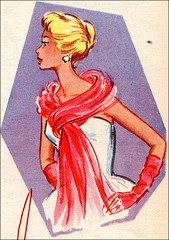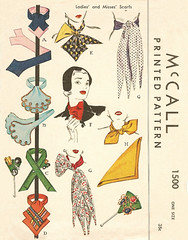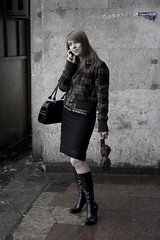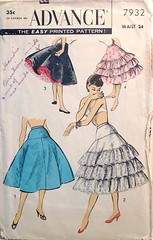Friday, January 27, 2012
gnocchi gnight!
I have moved up in the world. Not that you would know it, because I just deleted a beautiful post I was just about to offer you. Again.
In other news, I have advanced to wearing very nice blouses (which now inevitably smell of delicious food) whilst cooking tasty meals for two. And also wearing very vintage-looking apron given to me by my sweet sister Hyacinth, who finds me love of vintage housewifery amusing. (Fortunately her good taste helps me overlook the fact - thank you, dahling, for the Hollywood-red lipstick!)
This meal was phenomenal, though I must say that gnocchi-making is a long-preparation affair indeed, and rather labor-intensive. I encourage you to try it, though - it's delightful food, and can be frozen for future use. I plan to make it in huge batches in future. Hello, fifteen pounds of potatoes at a time!
I used this recipe (lemon-thyme sauce highly recommended!): Potato Gnocchi with Lemon-Thyme Sauce. And this recipe(s) offered some great insight and optional techniques: Italian dumplings with two sauces.
Here is me being fabulous making my lovely lemon-thyme-sauce gnocchi!
Sunday, January 22, 2012
The elements of style: tops
I was going to give this post a more specific title, but now that I've done some research, I've realized that specifics will have to wait for the next post. There's so much to cover! It's all quite fascinating, as you will learn if you keep reading. And now I realize, too, that "tops" can sound misleading... "toppings" are different than "tops," even if you are talking about just clothing. To settle this dispute, this is a blog post about tops. Not toppings, such as hats. Tops, like blouses, sweaters, etc. Things to wear on your top half.
While I would love to make this an exhaustive list of what to wear and how to wear it, we'll save that for the post on accessories. Today's fun entails the art of blouses, and elements such as wraps, cardigans, and jackets.
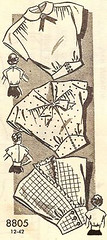


The set was very often a sleeveless top and bracelet- or full-length sleeved sweater, and usually high-necked, as shown. The collars could be simple or ornate - peter pan collars were common in the blouses, as were monograms and embroidery for the sweaters (although I doubt they were worn at the same time).
I've posted one of my outfits with a fitted jacket (and pencil skirt) to show how this can go - but mind you, this jacket is modern and rather a shoddy replica of the awesome things women wore sixty years ago. To help you find your own, I've included a few types and descriptions below.
I think these photographs give a good idea of how that works. Coco Chanel designed jackets like these that weren't fitted and were thus more practical for movement and popular with American women who couldn't quite get away with the haute couture look of the time.
These jackets are wonderful for suits with pencil skirts (the modern woman's suit blazer started as this) and emphasize the hourglass shape even though they are outer clothing.
The antithesis of this kind of jacket might be the loathsome anoraks people wore in the 1980s to evidently hide everything worth looking at and make women look like they have shoulders the height of the Sears Tower. Ick. You can find a picture of one here, but be warned: they are ugly enough to melt your eyeballs. A pox on anyone who tries to bring them back into fashion!
This wonderful style shows off more of the blouse and waistline than the other two jacket types, and is the most creative of all, as you can see from the picture. Some were made to match the skirts or dresses they outfitted, and some could be worn with other pieces. These days, they very often hang loosely so it's difficult to wear them with long sleeves. When shopping vintage, keep your eyes peeled for these short-sleeved, super-cropped jackets as a wonderful accessory to otherwise-mismatched outfits.
In the next post I'll discuss collars and necklines on blouses and gowns of all kinds. There's such a wide range, I couldn't include them in this post. Check back soon for the next installment of "The elements of style"!
Also, many thanks to Jessica of myvintagevogue.com for providing the bulk of the pictures for this post!
Blouses
I won't discuss all the styles for sleeves, necklines, or collars in this post, but I wanted to give you a smattering of different types of blouses worn with pencil skirts, circle skirts, and pants of all kinds. There are so many to choose from! I will say that sleeveless and capped-sleeve blouses were common, especially for young women. My opinion is that they were favored because they left lots of opportunity to mix and match jackets and sweaters, and because they made it easy to add or remove a layer when going out.


Sweater-set (or twin set)
School girls commonly wore these with poodle (circle) skirts, in the 1950s and 1960s. Made popular by screen stars such as Marilyn Monroe, Audrey Hepburn, and Grace Kelly (on and off the screen), this style of clothing usually looks knit (wool, lambswool, or cashmere), but can be made from synthetic fabric.Bodices
We'll talk about girdles later, but I have to point out that when you watch all those old movies where the girls' waists are completely slim and impossibly not-bulgy, this is an effect, not a naturally-occuring phenomenon. No matter how hard you try, without a girdle, you are going to bulge. Period, end of story. The point is, most real 1950s blouse bodices were made for a particular shape - made possible only by a girdle. They are fitted supremely, and in my opinion are lovely to look at when watching Mitzi Gaynor, Marilyn Monroe, or Rosemary Clooney movies.Jackets
I love jackets these days because they take the pressure off having the perfect figure for whatever I'm wearing. It helps that it's winter, but doesn't help that an outer coat is usually necessary on top of a jacket against the cold... but never mind my personal fashion problems. Jackets are wonderful. They provide (as interesting collars do) an opportunity for creativity with any outfit.Cropped
These short jackets change the silhouette, often making one's waist look as wide as one's hips. I like them, however, because they are usually short enough to emphasize the curvature of one's lower half and hint at the slimness of the waist above.Fitted
Bolero
Wraps, Shawls, Capes, and other draperies
This lovely pseudo-accessory offers plenty of room for creativity in one's outfit. I'm only just discovering them with my own wardrobe, but there are a lot of examples out there with which to swathe yourself. I've included just a few, with more of my own examples to come.Friday, January 6, 2012
A new thread
For those of us still en route to a home and lifestyle reminiscent of a prior century, there are many ways to thread old-fashioned ideals into everyday life. Some take the work away from the machines and put it back into our own hands, some require learning a new skill (or seven), and some are just practicing looking at the world differently.
From what I've seen of the people who really own the vintage lifestyle, they are the picture we want to see. They dress the part, they simplify their tools, and they spend their time and energy doing things technology could do faster and probably better - but less humanly. Life is about living, and I for one do not want to spend it staring into the screen of a smartphone.
Here I have compiled a list of behaviors - threads - of the life I choose to live this year.
The next time you're stopped at a traffic light watching cars go by, count how many people are on their cell phones. Or if you're in a crowded street, take a look at the pedestrians and count how many are texting or talking on the phone, obviously not mentally present in their environment. This is not the way I want to live.
This year, I choose not to make a text or call more important than the experience or person in my presence. Remember when telephones were only in your kitchen? Let's pretend that's where they were meant to be.
If you want to start sewing or mending your own clothes, here are some resources with tips and stitch types you can try as a beginner:
janegrey.hubpages.com/hub/How-to-Stitch-for-Sewing-and-Mending
www.coletterie.com/tutorials-tips-tricks
diyfashion.about.com/od/mendingandalterations
www.makeitandmendit.com
I also found a blog dedicated to sewing vintage at makingitvintage.blogspot.com. Lots of great ideas here!
If you want to start canning, here are some good resources for learning:
www.pickyourown.org
www.freshpreserving.com
www.amazon.com/Canning-New-Generation-Flavors-Modern
busterbucks.hubpages.com/hub/How-To-Can-Tomatoes
I also want to change my attitude towards shopping to something rather foreign - spending within my means. Whatever I buy, I have planned for. While credit itself has been around for more or less ever, credit cards are new and honestly of the devil. I refuse to be another of this country's horrendous statistics of people who spend money they don't have.
Also, it's time to get creative with gifts and household items! I've found a few websites that will allow me to maintain my zeal for change and excitement while keeping a respectful distance from my pocketbook:
http://iheartorganizing.blogspot.com
http://www.squidoo.com/reuse-everything
http://moneysavingfrugaltips.com
Anyway, moving on.
So I have this theory about the impossibly-tiny people who lived in this country half a century ago. Actually, two theories. One is that they were malnourished because the food they ate was limited by - well, a lot of things. The other is that they ate just fine, it's just that we are now enormous human beings because we eat just as much hormone as we do nutrient anymore. So this year, I resolve to go back to basics. We're talking fresh fruits and vegetables instead of canned and processed ones (unless homemade, of course), whole grains (such as my newly-beloved quinoa) instead of the useless sifted grain-product known to the wise as "empty calories" but otherwise known as "white flour," and lean meats--and less of them.
I've already begun to adjust my pantry to more organic and non-hormone-imbibed animal products and I have one thing to say: people should not be drinking milk produced by cows on steroids. I have very good reasons for saying this, but they stray too far from my vintage theme to be discussed here. The point is, that lovely lady I discussed in The living doll? She did not serve her family food on drugs, and therefore I refuse to, as much as possible. Her downfall was most likely Crisco, which, I am convinced, was the beginning of America's food problems.
Ok, enough about drugs. I have some recipes to share that our kitchen-bound women of the 1950s can only wish they'd known about. Here are some I have either tried and love or will try this year:
Quinoa chocolate cake
Baked kale chips (I like them with garlic and salt)
Quinoa chili (double the quinoa to make it last longer)
Zucchini with quinoa stuffing (my favorite quinoa recipe to date)
Stuffed eggplant
Rosted shrimp and orzo
Sesame soba noodle and veggie salad
Speaking of girlish figures, I also want to take more walks and enjoy the day because I'm convinced Americans drive too much. I blame the beautiful 1950s Cadillacs for making us want to drive everywhere instead of walk. Doubtless I would have a different opinion if I owned one myself, but in the meantime, this year is about diligence and discipline, and maybe even some tennis... but only because the outfits used to be fabulous.
Anyway, obviously real life in this century is not like that, no matter how much we make believe. However, inasmuch as my ingenuity allows, I resolve to a) participate in more social gatherings, and b) start practicing the piano and singing more often to be prepared in case we fall back into the 19th century. Community choir, don't start without me!
Cell phones
They are for talking and texting, yes, but not at the expense of living in the moment and being with the people who are with you. The person doesn't have to be there - he or she chooses to be.Mending
There always seems to be a pile somewhere, inevitable as laundry and dishes. This year I choose to make sewing a priority; a) because it's rather fun, b) because I don't like looking at the pile of clothes I wish I could wear, and c) because it requires that I slow down and live in the moment, stitch by stitch.janegrey.hubpages.com/hub/How-to-Stitch-for-Sewing-and-Mending
www.coletterie.com/tutorials-tips-tricks
diyfashion.about.com/od/mendingandalterations
www.makeitandmendit.com
Canning
I recently became aware of some serious health issues regarding store-bought canned tomatoes. I love using canned tomatoes in my cooking, so I am going to have to remedy this by canning my own. Time for some tomato plants in my garden! In any case, lots of delicious foods can be canned and I intend to experiment with them this year.www.pickyourown.org
www.freshpreserving.com
www.amazon.com/Canning-New-Generation-Flavors-Modern
busterbucks.hubpages.com/hub/How-To-Can-Tomatoes
Shopping... &c.
Big travel plans this year have thwarted my spontaneous spending habit, so now frugal's the word! I love to shop, especially vintage. This spring it will mean a lot of window shopping and digging around for the rarity of inexpensive finds.http://iheartorganizing.blogspot.com
http://www.squidoo.com/reuse-everything
http://moneysavingfrugaltips.com
Cooking
By the way, I hate it when I write a fabulous and sardonic section on how cooking will change my life this year, and then refresh the page without saving only to lose it all. Life hates me.Quinoa chocolate cake
Baked kale chips (I like them with garlic and salt)
Quinoa chili (double the quinoa to make it last longer)
Zucchini with quinoa stuffing (my favorite quinoa recipe to date)
Stuffed eggplant
Rosted shrimp and orzo
Sesame soba noodle and veggie salad
Writing
Okay, so work on the novel last year was short-lived. For something so long in coming, I'm disappointed that I didn't make more progress when I said I would. This year, I am determined. The fact that finishing it has been on my list of new year's goals for the last seven years is irrelevant. Also: more letters. Someday I might even write them in calligraphy. Journaling is also an important and satisfying re-addition to my life. In keeping with the vintage theme, I have a journal made from an old copy of Emily Dickinson's poems.Exercise
I always love the pictures of girl scouts from the '50s on hikes in the mountains. Exercise is not my favorite thing, but pictures like that inspire me and make me want to go do it. They did it without the help of spandex and breathable socks, so I have nothing to complain about. My only question is, when did they start selling cookies? And then how did they manage to keep their girlish figures after that?Reading
While I'd love to say I plan to read nothing but fashion history this year, I must be honest and admit my interests are more variable than that. I have some great Victorian history books (especially about the shift to home life) I'd like to read, and I may yet find my way to a Sears Roebuck catalogue. And perhaps I'll add a dash of Viktor Frankl and Dale Carnegie for good measure.Music
I love watching Jane Austen movies where you see these middle-class young women singing and playing the pianoforte at social gatherings. What's happened to the world?
Labels:
1950s,
canning,
cooking,
exercise,
fashion,
girl scouts,
kitchen,
mending,
music,
reading,
recipes,
sears roebuck,
sewing,
shopping,
telephones,
threads,
writing
Monday, December 19, 2011
Flashbacks
I've been very good the last two months about getting pictures taken in the most fabulous vintage outfits I've come up with from small acquisitions here and there. Posting them? Not so diligent on that front. So now here they are, from hats to hose, if not in my own collection, then what I envision in the near future.
A couple of months ago, my dear friend Birdie of Oak Tree Apothecary and I spent several days creating and canning homemade chili together. I was quite proud of my concoction - a delicious ensemble of beans, corn, ground beef, tomato puree, hominy, spices, and several secret ingredients.
Canning is a lovely sport made easier by friends with more knowledge than oneself. It makes large quantities of food last longer, and if said food is especially tasty, it's a way of inviting back the memory of a great day of cooking and canning and watching Poirot in the meantime.
Sidenote: Okay, is anyone else who read Atlas Shrugged annoyed that they set the movie in the modern day? The 1940s is a much better context, not only for its fabulous fashion, but also for its much-more-understandable background of railroads.
Anyway, canning day also happened to be pin-curl day, and I couldn't have my lovely curls falling into the chili, could I? So I wrapped them up into a turban of sorts with a pink scarf. I learned a better way from Solanah at Vixen Vintage, but my scarf has no stretchability, so I satisfied myself with a lounging bow atop my head.
Incidentally, after getting myself used to doing a pin curl set, I've found it requires both diligence and strong arms. It isn't the kind of thing one can just do in five minutes, and for that I both respect the process and fear it. The result is always fabulous - once you've gotten the hang of it - so in my view, always worth doing. Do read what Solanah has to say about pin curls, though, to get a feel for how a regular pin-curler plans the process.
The photos below highlight several ideals of vintage periods (as you may have now noted, I tend to stick with the mid-20th century).
Bottom-left: satin hat with brooch, textured scarf as belt, blouse tucked in
Center: textured blouse tucked in, high-waisted skirt, bright belt, satin wrap Bottom-right: pin curls wrapped forward at each side and bangs back, pill box hat, fitted heavy-wool coat, reminiscent of the Dior A-line
A couple of months ago, my dear friend Birdie of Oak Tree Apothecary and I spent several days creating and canning homemade chili together. I was quite proud of my concoction - a delicious ensemble of beans, corn, ground beef, tomato puree, hominy, spices, and several secret ingredients.
Canning is a lovely sport made easier by friends with more knowledge than oneself. It makes large quantities of food last longer, and if said food is especially tasty, it's a way of inviting back the memory of a great day of cooking and canning and watching Poirot in the meantime.
Sidenote: Okay, is anyone else who read Atlas Shrugged annoyed that they set the movie in the modern day? The 1940s is a much better context, not only for its fabulous fashion, but also for its much-more-understandable background of railroads.
Anyway, canning day also happened to be pin-curl day, and I couldn't have my lovely curls falling into the chili, could I? So I wrapped them up into a turban of sorts with a pink scarf. I learned a better way from Solanah at Vixen Vintage, but my scarf has no stretchability, so I satisfied myself with a lounging bow atop my head.
Incidentally, after getting myself used to doing a pin curl set, I've found it requires both diligence and strong arms. It isn't the kind of thing one can just do in five minutes, and for that I both respect the process and fear it. The result is always fabulous - once you've gotten the hang of it - so in my view, always worth doing. Do read what Solanah has to say about pin curls, though, to get a feel for how a regular pin-curler plans the process.
The photos below highlight several ideals of vintage periods (as you may have now noted, I tend to stick with the mid-20th century).
Bottom-left: satin hat with brooch, textured scarf as belt, blouse tucked in
Center: textured blouse tucked in, high-waisted skirt, bright belt, satin wrap Bottom-right: pin curls wrapped forward at each side and bangs back, pill box hat, fitted heavy-wool coat, reminiscent of the Dior A-line
More delightful vintage ensembles to come!
Friday, December 9, 2011
The elements of style: bottoms! ...sort of
A woman’s closet sixty years ago included several items we won’t find in our own. Girdles, for example, are literally a thing of the past. But that doesn’t mean they can’t be resurrected! There were different styles for different kinds of women, so this exploration, while by no means exhaustive, is intended to cover the basic elements of style for the beatnik babe to our effervescent housewife, and perhaps a few in between.
Here are a few items typically found in a woman’s closet during the decade that idealized the “living doll.” We are keeping ourselves to the bottom half for the moment, as there are many pieces to discuss. I hope someday to include them all in my own antique armoire (as yet to be purchased), but we’ll take it a step at a time.
Here are a few items typically found in a woman’s closet during the decade that idealized the “living doll.” We are keeping ourselves to the bottom half for the moment, as there are many pieces to discuss. I hope someday to include them all in my own antique armoire (as yet to be purchased), but we’ll take it a step at a time.
This skirt, if laid out on the floor, is a complete circle. At the waist, all the material is gathered. Most skirts of this kind are not pleated or gathered unevenly--that would defeat the purpose. The purpose, if it is not obvious, is to allow the wearer to twirl magnificently across the floor, hopefully showing off no more than the dense fluff of ruffles that is her petticoat. As a child, I loved them because I could sit on the floor most romantically, my skirt spread out in all directions and able to cover me no matter how I sat. For more info, check out the post on circle skirts at This Girls Vintage blog.
This lovely item is a terror to one's closet (don't even think of storing it in a drawer!) and is the main reason, I am convinced, that women kept their clothes in large trunks at the foot of their beds. Petticoats can be very thin: a single layer of fabric gathered and ruffled to add volume to the skirt shape over top of it. Mostly, though, at least through the 1950s, they were ruffled and layered to the extreme to increase volume to circle skirts, and also to allow enterprising dancers to practice their can-cans with some degree of modesty. For more info, check out this section of Fashion-era.com. Also see Flounce, below.
Made extremely popular by Christian Dior (also attributed to designer Jacques Fath, whose sketch is shown at left), this skirt--like the circle skirt--is well-known for its ability to promote a certain silhouette. It accentuates one's natural curves by hugging all of them, sometimes (preposterously) past the knee. Think about trying to walk with your knees bound together. Still, I prefer this skirt over the circle skirt because of how it lends itself to a womanly maturity where the other does not. If you look for vintage skirts of this kind in thrift stores or vintage shops, take care to only buy skirts either with a lining or clearly made of a strong, firm fabric well-sewn. The best, of course, are tailor-made for one's figure, but as most of us cannot afford such luxury, we must make do with skirts that will at least avoid the risk of embarrassing us in public by tearing disastrously and always at the wrong time. A more full description can be found at the HeyViv blog.
One of my favorite words to say aloud. And strictly speaking, it isn't a garment of itself. Flounces are simply stiff, ostentatious ruffles - down the side of a gown, for instance. On collars, flounces are distinguished from ruffles in that they stand up while ruffles lay down. On skirts, picture Scarlett O'Hara in her white ball gown. Those are flounces. Flounces in the 1950s are better observed in the image at the right. They can edge sleeves, make skirts more exciting (as they are usually visible a few inches below the hemline), or insist on being the whole skirt, as with Scarlett. Buoyant and fun, flounces are decidedly my favorite garment embellishments. Learn how to make them yourself from the Off the Cuff blog!
Cropped pants / pedal-pushers / Capri pants
Christian Dior ushered in the era of cropped, fitted pants and cropped blouses, along with about a hundred other fashion concepts. These pants were useful to women who regularly rode bicycles (wider-legged pants and skirts tended to get caught in chains and gears) and were iconic for young people in the '50s and '60s.
It should be noted that Capri pants were designed and introduced by Sonja de Lennart in the 1940s, but are also attributed to Emilio Pucci who sold them in his boutique on the Isle of Capri in the late 1940s. They were made famous when Hollywood costume designers used them in such movies as Roman Holiday and Sabrina, and were quite frequently paired with ballet flats (a style happily resurrected in the last decade). A history of Capri pants can be found at SpeakFashion.us.
It should be noted that Capri pants were designed and introduced by Sonja de Lennart in the 1940s, but are also attributed to Emilio Pucci who sold them in his boutique on the Isle of Capri in the late 1940s. They were made famous when Hollywood costume designers used them in such movies as Roman Holiday and Sabrina, and were quite frequently paired with ballet flats (a style happily resurrected in the last decade). A history of Capri pants can be found at SpeakFashion.us.
Dungarees (a.k.a. jeans)
Personally, I prefer the term "dungarees," so I might start a campaign to resurrect it. Back in the day, you couldn't find them made with comfortably-stretchy spandex - they were just denim. Most of us have worn just-denim jeans… and most of us prefer the way that bit of spandex allows them to move with you. They were originally designed for cowboys (and are still worn by them), but became popular with teenagers in the 1950s. You'll likely recognize the original brands - Levi's, Lee, and Wrangler.
James Dean popularized them among teens with his movie Rebel Without A Cause. For a while, dungarees were banned from theaters, restaurants, and schools because of their rebellious and untraditional connotations. The image seems to have stayed with us in some ways - jeans are decidedly not "formal attire" or appropriate for many formal functions. A little more of their history can be found at eHow.com.
James Dean popularized them among teens with his movie Rebel Without A Cause. For a while, dungarees were banned from theaters, restaurants, and schools because of their rebellious and untraditional connotations. The image seems to have stayed with us in some ways - jeans are decidedly not "formal attire" or appropriate for many formal functions. A little more of their history can be found at eHow.com.
In Part 2, we'll explore tops of all kinds. Also check back for posts on outerwear, unmentionables, shoes, and accessories. There's a world of vintage fashion to investigate and try on for ourselves, and we've only touched the surface!
Subscribe to:
Posts (Atom)















